UPDATE: Thermalright Ultra-120 eXtreme - Retail
by Wesley Fink on May 4, 2007 3:00 AM EST- Posted in
- Cases/Cooling/PSUs
Ultra-120 eXtreme Production Kit
As we have said many times, Thermalright has never been one to invest in fancy packaging. The usual Thermalright cooler comes in a sturdy brown box, with at least the name nowadays. What's in the box is what really matters, and Thermalright has more often than not delivered some of the best coolers on the market.

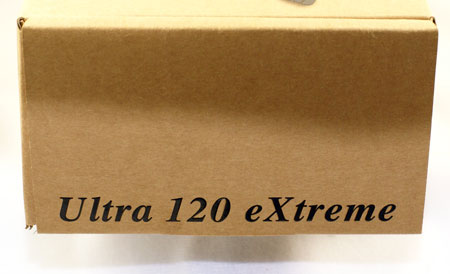
Thermalright is really proud of the Ultra-120 eXtreme, at least based on the final packaging. This is the first time Thermalright has used big 3-D Shadow print to announce the name.
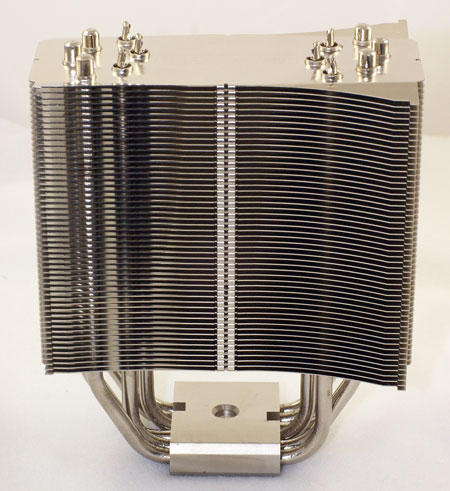
We looked closely, but we really couldn't find any difference in the prototype we tested and the retail eXtreme tower. Perhaps some sharp-eyed readers will find subtle improvements that found their way into the production eXtreme.
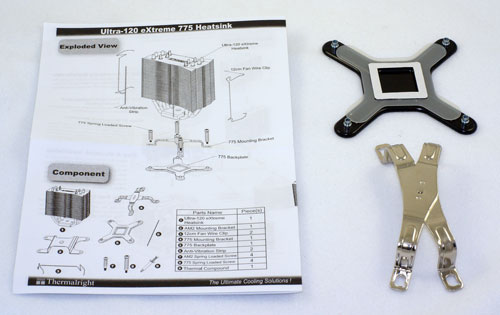
The AM2 plate is the same, but the socket 775 plate is a complete redesign. The original 775 mount would not fit between the extra pipes of the eXtreme. The revised 775 mount folds, and is easily passed through the tighter pipes on the eXtreme.
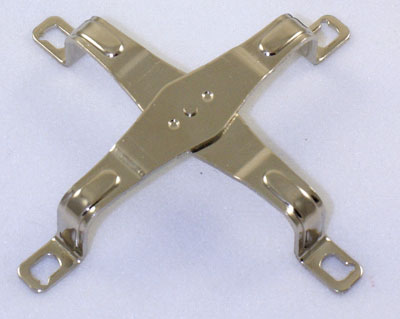
Once passed through the pipes, the 775 adapter is pushed open to align with the mounting holes. The back plate has also been slightly altered to allow better electrical isolation of the metal back plate. There are now elastomer pads on the motherboard contact surfaces.

The new socket 775 adapter is certainly an improvement over the older design in terms of convenience, but we still have one complaint. The old adapter held the cooler firmly in place on socket 775, while the new adapter allows the cooler to be turned a bit after mounting, whether intentional or accidental. Buyers will be perfectly happy with the eXtreme's mounting and performance, but the 775 bracket could be improved further with wider metal on one of the blades that secures the cooler so it won't be able to turn. In this aspect the AM2 adapter is really sturdier, since the heatpipe tower is held rigidly in place on socket AM2 after mounting.
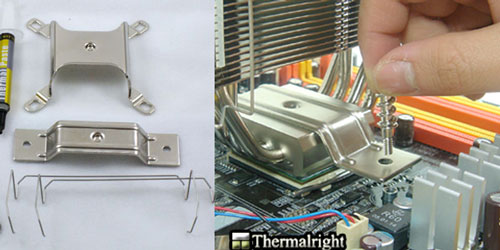
It is also important to understand that the Ultra-120 eXtreme comes with AM2 and socket 775 adapters. However, it does not ship with the AMD 754/939/940 adapter. There is a 754/939/940 adapter (K8) in the Ultra-120 kit. It will also fit the eXtreme so that it can be used on the slightly older AMD sockets. If you want to use the eXtreme on an AMD 754/939/940 processor you will need to ask Thermalright to sell you the Ultra-120 AMD K8 adapter, or talk your dealer or a U120-owning friend into helping you out.
As we have said many times, Thermalright has never been one to invest in fancy packaging. The usual Thermalright cooler comes in a sturdy brown box, with at least the name nowadays. What's in the box is what really matters, and Thermalright has more often than not delivered some of the best coolers on the market.


Thermalright is really proud of the Ultra-120 eXtreme, at least based on the final packaging. This is the first time Thermalright has used big 3-D Shadow print to announce the name.

We looked closely, but we really couldn't find any difference in the prototype we tested and the retail eXtreme tower. Perhaps some sharp-eyed readers will find subtle improvements that found their way into the production eXtreme.

The AM2 plate is the same, but the socket 775 plate is a complete redesign. The original 775 mount would not fit between the extra pipes of the eXtreme. The revised 775 mount folds, and is easily passed through the tighter pipes on the eXtreme.

Once passed through the pipes, the 775 adapter is pushed open to align with the mounting holes. The back plate has also been slightly altered to allow better electrical isolation of the metal back plate. There are now elastomer pads on the motherboard contact surfaces.

The new socket 775 adapter is certainly an improvement over the older design in terms of convenience, but we still have one complaint. The old adapter held the cooler firmly in place on socket 775, while the new adapter allows the cooler to be turned a bit after mounting, whether intentional or accidental. Buyers will be perfectly happy with the eXtreme's mounting and performance, but the 775 bracket could be improved further with wider metal on one of the blades that secures the cooler so it won't be able to turn. In this aspect the AM2 adapter is really sturdier, since the heatpipe tower is held rigidly in place on socket AM2 after mounting.

It is also important to understand that the Ultra-120 eXtreme comes with AM2 and socket 775 adapters. However, it does not ship with the AMD 754/939/940 adapter. There is a 754/939/940 adapter (K8) in the Ultra-120 kit. It will also fit the eXtreme so that it can be used on the slightly older AMD sockets. If you want to use the eXtreme on an AMD 754/939/940 processor you will need to ask Thermalright to sell you the Ultra-120 AMD K8 adapter, or talk your dealer or a U120-owning friend into helping you out.










44 Comments
View All Comments
JarredWalton - Saturday, May 5, 2007 - link
Wes looked at that in the earlier article, and depending on your PSU/case configuration it can certainly function fanless. Overclocking fanless isn't recommended, and I personally think you should still have some low RPM fans in every PC to be safe. If you undervolt a 120mm fan so it's only running at 400 RPM or so (or even the stock 800 RPM), it will still be inaudible and yet it will make a huge difference in cooling performance.fasdl - Saturday, May 5, 2007 - link
wow, those numbers are unreal! I can't believe this thing is really that good. Is this better at the point where it's better than water cooling?vailr - Friday, May 4, 2007 - link
Suggestion to Thermalright: replace the metal backplate; go to a non-conducting material. Such as found in the Zalman CS-2:http://sharkacomputers.com/zacsclsuforl.html">http://sharkacomputers.com/zacsclsuforl.html
Magnadoodle - Friday, May 4, 2007 - link
Thermalright products are know to perform better with more airflow while Scythe products usually perform better at low airflows. It would be interesting to test the passive cooling performance of the heatsinks, although that would imply alot of testing.noobzter - Friday, May 4, 2007 - link
Is it sticky? If it is, I wonder whether performance is affected if one were to use AS5.bigpow - Friday, May 4, 2007 - link
instead of using static charts for comparison tests, why don't you use a javascript-based chart?That'd allow readers to check/uncheck whats on the chart - just like the one on Yahoo stock chart
I haven't seen any other IT websites using this method, and it's only natural if Anandtech.com (my fav site) is the 1st one to have "live" chart
JarredWalton - Saturday, May 5, 2007 - link
I would *love* to have such a tool, mostly because the scaling graphs right now can be quite a pain in the hind quarters to generate. Unfortunately, such a tool takes development time, and while our web programmers are working on an overhaul of the graphing engine (and document engine in general) I'm not sure if we'll get an on-the-fly graph tool. I'll send the suggestion their way, though - it's at least worth considering, although server load might be a problem with such a design as well. We periodically get people that can't see some of the images for a variety of reasons, so any programmed graphics might be more trouble than they're worth. We'll see....Howard - Friday, May 4, 2007 - link
That way, you don't have to worry about the ambient temperature.Final Hamlet - Friday, May 4, 2007 - link
I really am interested in silencing my AM2 X2 3800+ - is it possible to run my CPU without any fans if I add a TR 120?Ender17 - Friday, May 4, 2007 - link
Great review, any idea when we can see a comparison with the IFX-14?